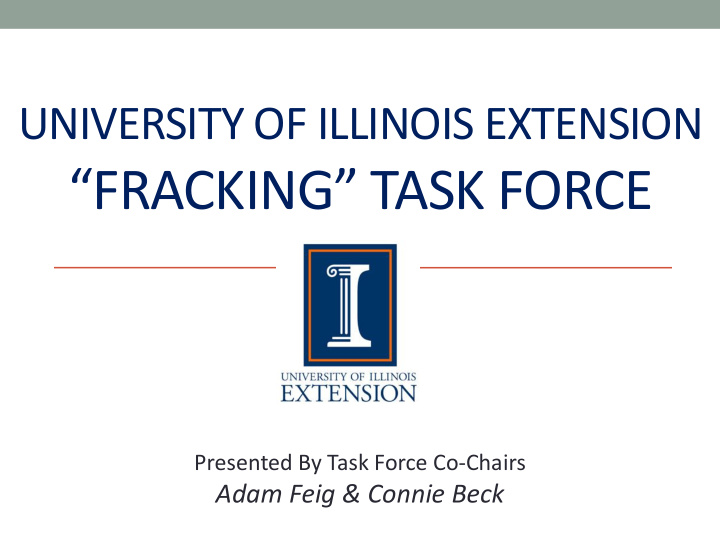



UNIVERSITY OF ILLINOIS EXTENSION “FRACKING” TASK FORCE Presented By Task Force Co-Chairs Adam Feig & Connie Beck
Mission The Horizontal Drilling “ Fracking ” Task Force at the University of Illinois Extension seeks to facilitate the dissemination of unbiased, scientific-based, information resulting in improved and informed decision making for our local stakeholders and clientele. PRO CON
Task Force Team Members • Adam Feig, Extension Director, Co-Chair • Connie Beck, Extension Director, Co-Chair • Susan Odum, Extension Educator, CED • Zachary Kennedy, Extension Educator, CED • Matt Rush, Program Coordinator, ANR • Nathan Johanning, Extension Educator, ANR • Jason Haupt, Extension Educator, ANR • Dr. Dale Law, Regional Director • Dr. Mike Gray, Professor/Assistant Dean, ANR
Goals of the Task Force • Increasing awareness and understanding of the long term impacts of the leasing, implementation, recovery, and restoration efforts associated with “Fracking”. • Improving the quality of life and economic viability of rural clientele, stakeholders, and local communities. • Ensuring long-term environmental quality and sustainability. • Improving social and economic conditions in our communities. • Preparing our communities to prevent and respond to emergencies.
Background • Task Force was created in March 2012 when leasing efforts became prevalent in Wayne County. • Hosted 10+ informational sessions throughout Southern Illinois on leasing, current issues, legislative updates, and provided audiences with opportunities to have questions answered.
Background • Conducted a site visit to southeastern Ohio in December of 2012 in partnership with representatives of Ohio State University Extension. • Visited numerous well sites in Ohio and spoke with local landowners and community leaders.
Background
Services • Presentations/Informational Meetings • Fact Sheets • Gathering Unbiased Research • Review of Best Practices • Money Management Programs • Informational Website (Under Development) • Staying Abreast of Issues & Developments
Audiences • Landowners/Mineral Rights Owners • Local Governments (Various Levels) • Community Leaders • Local Business Owners • Environmental Groups • Special Interest Groups • Local Media
The Illinois Basin http://dnr.state.il.us/mines/dog/images/mape.gif
Illinois Oil & Gas Resources Jasper Effingham Fayette Crawford Clay Lawrence Richland Marion Wabash Edwards Wayne Jefferson Hamilton White Franklin Gallatin Williamson Saline http://moulin.isgs.uiuc.edu/ILOIL/webapp/ILOIL.html
What We Have Learned Hydraulic fracturing, which is commonly referred to as fracking, is nothing new. Hydraulic fracturing is achieved by pumping water mixed with sand and chemicals through a well into rock that holds a carbon fuel, such as oil or natural gas. The water creates pressure, which fractures the rock or opens up pre- existing cracks. The sand holds the cracks open so the gas and/or oil can be extracted. A Graphic of the Process from the Marcellus Shale Region Source: Illinois Issues, a publication of the University of Illinois Springfield, May 2012
What We Have Learned What is new about recent fracking projects is their scale. Fracking coupled with horizontal drilling allows gas and oil companies to drill down into the earth and then permeate rock along a horizontal line, which is sometimes miles long. The combination of the two technologies has some thinking that there is a chance to reach oil and natural gas in Illinois that was previously too difficult or not economically viable to go after. A Graphic of the Process from the Marcellus Shale Region Source: Illinois Issues, a publication of the University of Illinois Springfield, May 2012
What We Have Learned “It’s sometimes portrayed as some new technology. That really misses the mark,” says Brad Richards, executive vice president of the Illinois Oil & Gas Association. “It is bigger, and it is different.” David Morse, senior petroleum geologist and head of the Coal and Petroleum Geology Section at the Illinois State Geological Survey, agrees. “We’ve certainly fracked oil wells for the last 60 years in Illinois. What makes this fracking different is definitely the scale. ” Morse said that while previously fracked wells may have had about 100,000 gallons of fluids pumped down them, new larger wells could potentially have 1 million to 5 million gallons pumped into them. Source: Illinois Issues, a publication of the University of Illinois Springfield, May 2012
What We Have Learned Source: Illinois e-News Summaries [e-Subscription@illinois.gov]
Recommend
More recommend